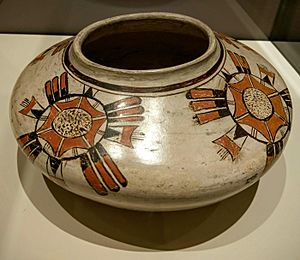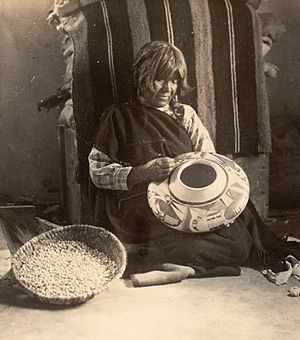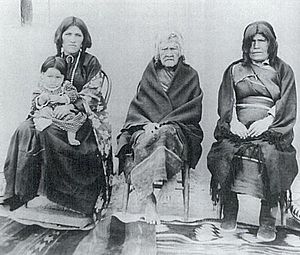Nampeyo facts for kids
Quick facts for kids
Nampeyo
|
|
|---|---|
| Num-pa-yu (Tewa: snake that does not bite) |
|
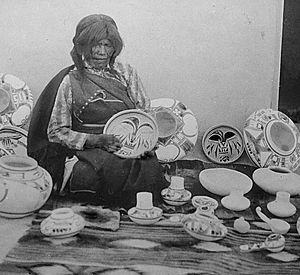
Nampeyo, ca. 1900, photograph by A.C. Vroman
|
|
| Born | 1859 Hano pueblo, Arizona
|
| Died | 1942 Arizona
|
| Nationality | Hopi-Tewa (United States) |
| Known for | ceramic artist |
| Movement | Sikyátki Revival |
| Spouse(s) | Lesou (second husband) |
Nampeyo (1859 – 1942) was a famous Hopi-Tewa artist. She lived on the Hopi Reservation in Arizona. Her Tewa name, Num-pa-yu, means "snake that does not bite."
Nampeyo used old ways to make and fire her pottery. She copied designs from "Old Hopi" pottery. These designs came from pieces found at the 15th-century Sikyátki ruins. Her beautiful artwork is now in museums across the United States and Europe. These include the National Museum of American Art and the Peabody Museum of Archaeology and Ethnology.
In 2010, one of her decorated pots sold for $350,000. This set a new world record for Southwest American Indian pottery!
Contents
Early Life of Nampeyo
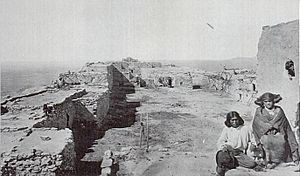
Nampeyo was born in 1859 in Hano village. This village is also called Tewa Village. Many people there are descendants of the Tewa people. They moved to Hopi lands around 1702. This was to find safety from the Spanish.
Nampeyo's mother, White Corn, was Tewa. Her father, Quootsva, was from Walpi. He was part of the Snake clan. Nampeyo was born into her mother's Tewa Corn clan. She had three older brothers: Tom Polacca, Kano, and Patuntupi. Nampeyo never went to school. She could not read or write.
A photographer named William Henry Jackson took her picture in 1875. She was one of the most photographed pottery artists in the Southwest during the 1870s.
Around 1878 or 1881, Nampeyo married her second husband, Lesou. He was from the Cedarwood clan at Walpi. They had five children. Their first daughter, Annie, was born in 1884. Their last child, Fannie, was born in 1900.
Nampeyo's Amazing Artwork
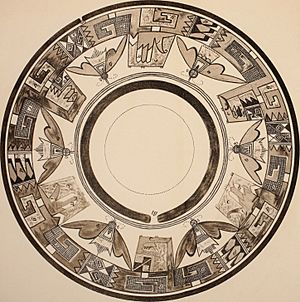
Hopi people create pottery with beautiful designs. Nampeyo became known as one of the best Hopi potters. She learned how to make pottery from her grandmother. By the 1870s, she earned money selling her work. She sold it at a local trading post. By 1881, she was famous for her "old Hopi" pottery.
Nampeyo became very interested in ancient pottery. She felt its shapes and designs were better than newer pottery. Her husband, Lesou, helped an archaeologist named J. Walter Fewkes. They worked at the Sikyátki ruin in the 1890s. Lesou found old pottery pieces, called potsherds. Nampeyo and Lesou copied the ancient designs. She then used these designs on her own pottery.
She created her own style based on these old designs. This style is called Hopi Revival pottery. It combines old Hopi designs with Sikyátki pottery. This is why experts call her style Sikyatki Revival.
Her pottery became very popular. People bought it all over the United States and Europe.
When I first began to paint, I used to go to the ancient village and pick up pieces of pottery and copy the designs. That is how I learned to paint. But now, I just close my eyes and see designs and I paint them.
– Nampeyo, 1920s
An artist named Kate Cory lived with the Hopi people. She wrote about Nampeyo's special techniques. Nampeyo used sheep bones in her fire. This made the fire hotter or the pottery whiter. She also smoothed her pots with a plant. These were old Tewa pottery methods. Nampeyo sometimes used up to five different clays. Most potters only used two.
Nampeyo and her husband traveled to Chicago in 1898. They went there to show her pottery. From 1905 to 1907, she sold pottery at Hopi House. This was a tourist spot at the Grand Canyon. She also showed her work at an exhibition in Chicago in 1910.
One of her famous designs was the migration pattern. It showed the journey of the Hopi people. It used feather and bird-claw shapes. A vase from the 1930s has this design. It is now in the National Museum of the American Indian. Her pottery is special because of its shapes and designs. She made wide, low, rounded pots. Later, she made tall jars. Her unique designs make her work easy to spot.
Nampeyo's picture was often used on travel brochures. These brochures promoted the American Southwest.
Around 1900, Nampeyo started to lose her eyesight. She had a condition called trachoma. From 1925 until she died, she made pottery by touch. Her husband, daughters, or other family members then painted them.
In 2010, one of her pots sold for $350,000. It had round shapes and Hopi Kachina figures. These figures had "stylized faces" and "flamboyant headdresses." This pot was once owned by Carter Harrison Jr., a former mayor of Chicago.
Nampeyo's Legacy
Nampeyo passed away in 1942. She died at the home of her son Wesley.
She became a symbol for the Hopi people. She helped bring back ancient pottery traditions. Nampeyo inspired many family members to make pottery. This included her daughters Fannie Nampeyo and Annie Healing. A 2014 exhibit showed the work of four generations of artists. All of them were descended from Nampeyo.
Where to See Her Art
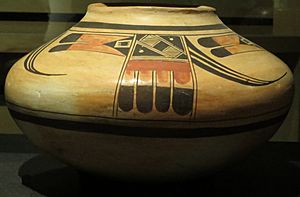
You can find Nampeyo's artwork in many public collections, including:
- Arizona State Museum, University of Arizona
- Denver Art Museum, Colorado
- Kansas City Museum, Kansas City, MO
- Millicent Rogers Museum, Taos, NM
- Museum of Northern Arizona, Flagstaff, AZ
- National Museum of the American Indian, Smithsonian Institution, Washington, DC
- Peabody Museum of Archaeology and Ethnology, Harvard University, Cambridge, MA
- Museum of Indian Arts and Culture/Laboratory of Anthropology, Santa Fe, NM
- Haffenreffer Museum of Anthropology at Brown University, Providence, RI
See also
 In Spanish: Nampeyo para niños
In Spanish: Nampeyo para niños
- Fannie Nampeyo, her daughter
- Daisy Hooee, her granddaughter
- Elva Nampeyo, her granddaughter
- Dextra Nampeyo Quotskuyva, her great-granddaughter
- Priscilla Namingha, her great-granddaughter
- Dan Namingha, her great-great grandson
- Ida Sahmie, her great-great daughter-in-law
- Nampeyo (crater), a crater on Mercury named after her


